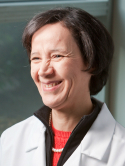| Abstract: |
We studied the feasibility of a novel approach to localize breast cancer susceptibility genes, using a low-density genome-wide panel of single-nucleotide polymorphisms and taking advantage of large regions of linkage disequilibrium (LD) flanking Jewish disease genes in high-risk cases. With Affymetrix GeneChip arrays, we genotyped 8,576 polymorphisms in three sets of Ashkenazi Jewish breast cancer cases: a "validation" set of 27 breast cancer cases, all of whom carried the BRCA2*6174delT founder mutation; a "field" set of 19 breast cancer cases from male breast cancer kindreds, which simulated conditions for finding new genes; and a "test" set of 57 probands from breast cancer kindreds (4 or more cases/kindred), in which mutations in BRCA1 and BRCA2 had been excluded. To identify associations, we compared the frequency of genotypes and haplotypes in cases vs. controls by the Fisher's exact test and a maximum likelihood ratio test. In the "validation" set, we demonstrated the presence of a region of linkage disequilibrium on BRCA2*6174delT chromosomes that spanned over 5 million bases. In the "field" set, we showed that this large region of linkage disequilibrium flanking BRCA2 was detectable despite the presence of heterogeneity in the sample set. Finally, in the "test" set, at least three regions of interest emerged that could contain novel breast cancer genes, one of which had been identified previously by linkage analysis. While these results demonstrate the feasibility of genome-wide association strategies, further application of this approach will critically depend on optimizing the density and distribution of SNPs and the size and type of study design. © 2005 Wiley-Liss, Inc. |






